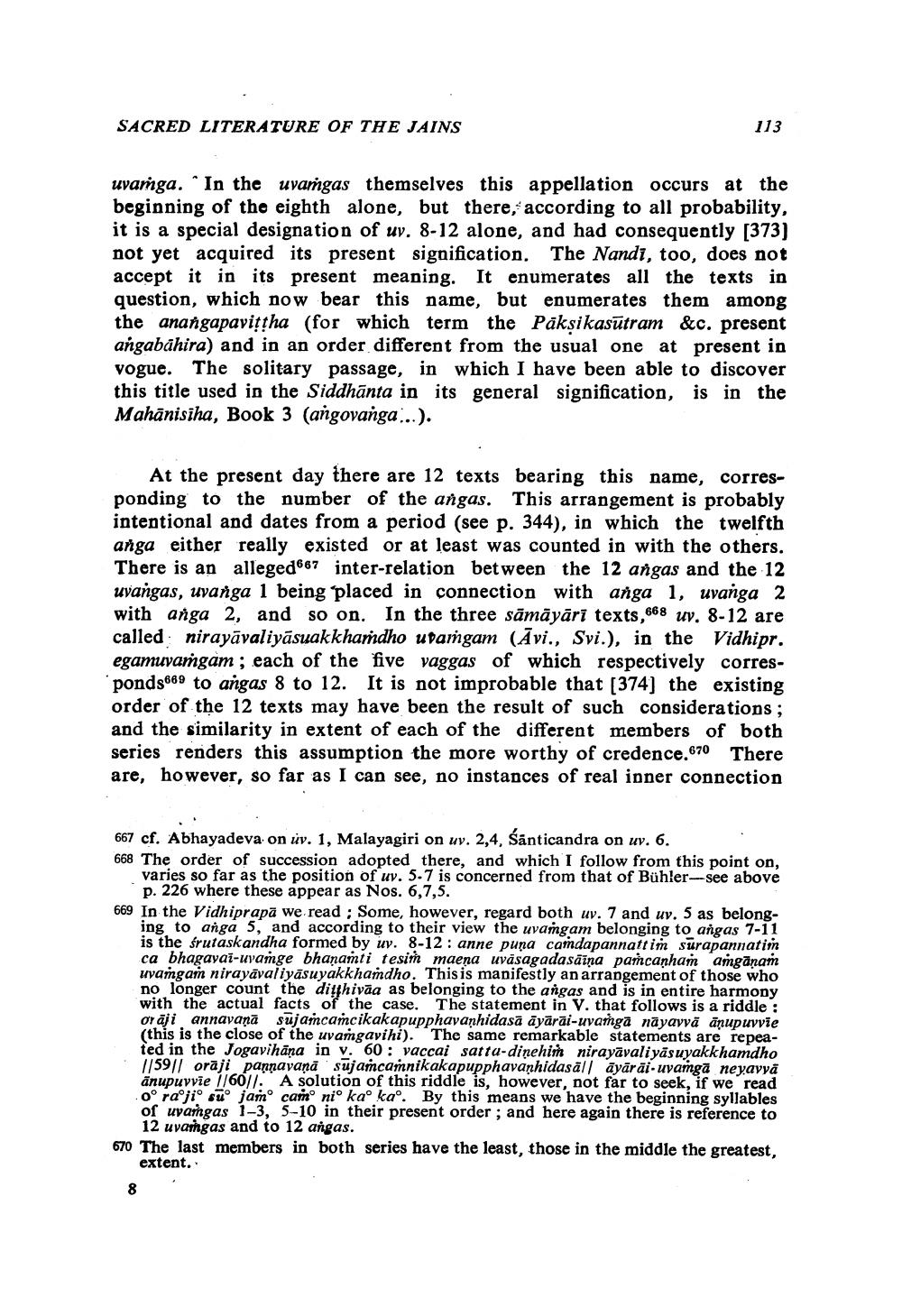________________
SACRED LITERATURE OF THE JAINS
113
uvamga. In the uvamgas themselves this appellation occurs at the beginning of the eighth alone, but there, according to all probability, it is a special designation of uv. 8-12 alone, and had consequently [373] not yet acquired its present signification. The Nandi, too, does not accept it in its present meaning. It enumerates all the texts in question, which now bear this name, but enumerates them among the anangapaviṭṭha (for which term the Pākṣikasūtram &c. present angabahira) and in an order different from the usual one at present in vogue. The solitary passage, in which I have been able to discover this title used in the Siddhanta in its general signification, is in the Mahānisiha, Book 3 (angovanga...).
At the present day there are 12 texts bearing this name, corresponding to the number of the angas. This arrangement is probably intentional and dates from a period (see p. 344), in which the twelfth anga either really existed or at least was counted in with the others. There is an alleged667 inter-relation between the 12 angas and the 12 uvangas, uvanga 1 being placed in connection with anga 1, uvanga 2 with anga 2, and so on. In the three sāmāyārī texts,668 uv. 8-12 are called nirayavaliyāsuakkhamdho utamgam (Avi., Svi.), in the Vidhipr. egamuvamgam; each of the five vaggas of which respectively corresponds669 to angas 8 to 12. It is not improbable that [374] the existing order of the 12 texts may have been the result of such considerations; and the similarity in extent of each of the different members of both series renders this assumption the more worthy of credence.670 There are, however, so far as I can see, no instances of real inner connection
667 cf. Abhayadeva on uv. 1, Malayagiri on uv. 2,4, Śanticandra on uv. 6.
668 The order of succession adopted there, and which I follow from this point on, varies so far as the position of uv. 5-7 is concerned from that of Bühler-see above p. 226 where these appear as Nos. 6,7,5.
669 In the Vidhiprapa we read; Some, however, regard both uv. 7 and uv. 5 as belonging to anga 5, and according to their view the uvamgam belonging to angas 7-11 is the frutaskandha formed by uv. 8-12: anne puna camdapannattim surapannatim ca bhagavai-uvamge bhanamti tesim maena uvasagadasaina pamcanham amganam uvamgam nirayavaliyasuyakkhamdho. This is manifestly an arrangement of those who no longer count the dihivaa as belonging to the angas and is in entire harmony with the actual facts of the case. The statement in V. that follows is a riddle: oraji annavana sujamcamcikakapupphavaḥhidasa ayarai-uvamga nayavvā āṇupuvvie (this is the close of the uvamgavihi). The same remarkable statements are repeated in the Jogavihana in v. 60: vaccai satta-dinehim nirayavaliyasuyakkhamdho 1/59/ oraji pannavana sujamcamnikakapupphavaṇhidasal ayarai-uvamga neyavva anupuvvie 1/60//. A solution of this riddle is, however, not far to seek, if we read 0° raji su jam cam ni ka ka°. By this means we have the beginning syllables of uvaigas 1-3, 5-10 in their present order; and here again there is reference to 12 uvamgas and to 12 angas.
670 The last members in both series have the least, those in the middle the greatest, extent..
8




